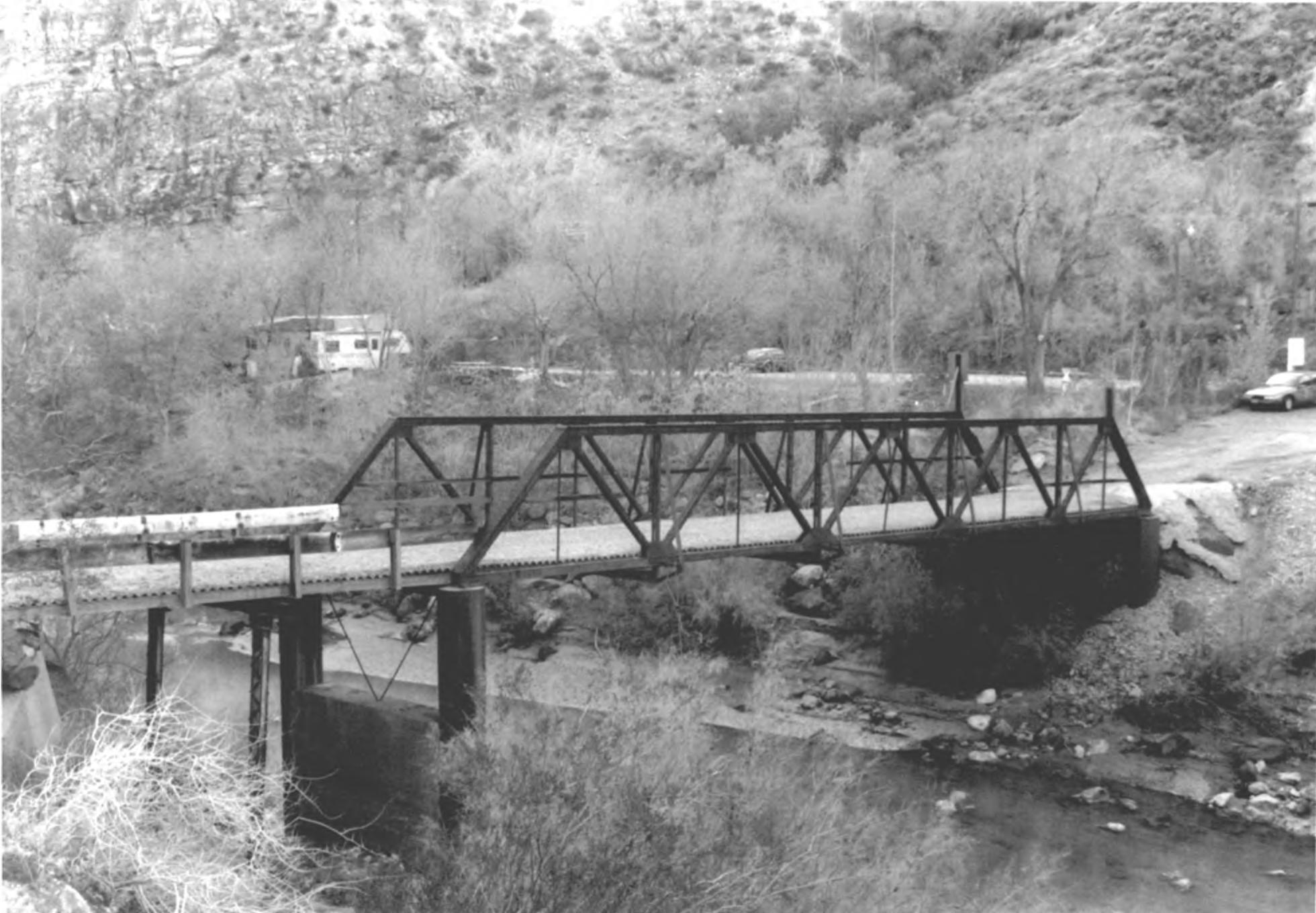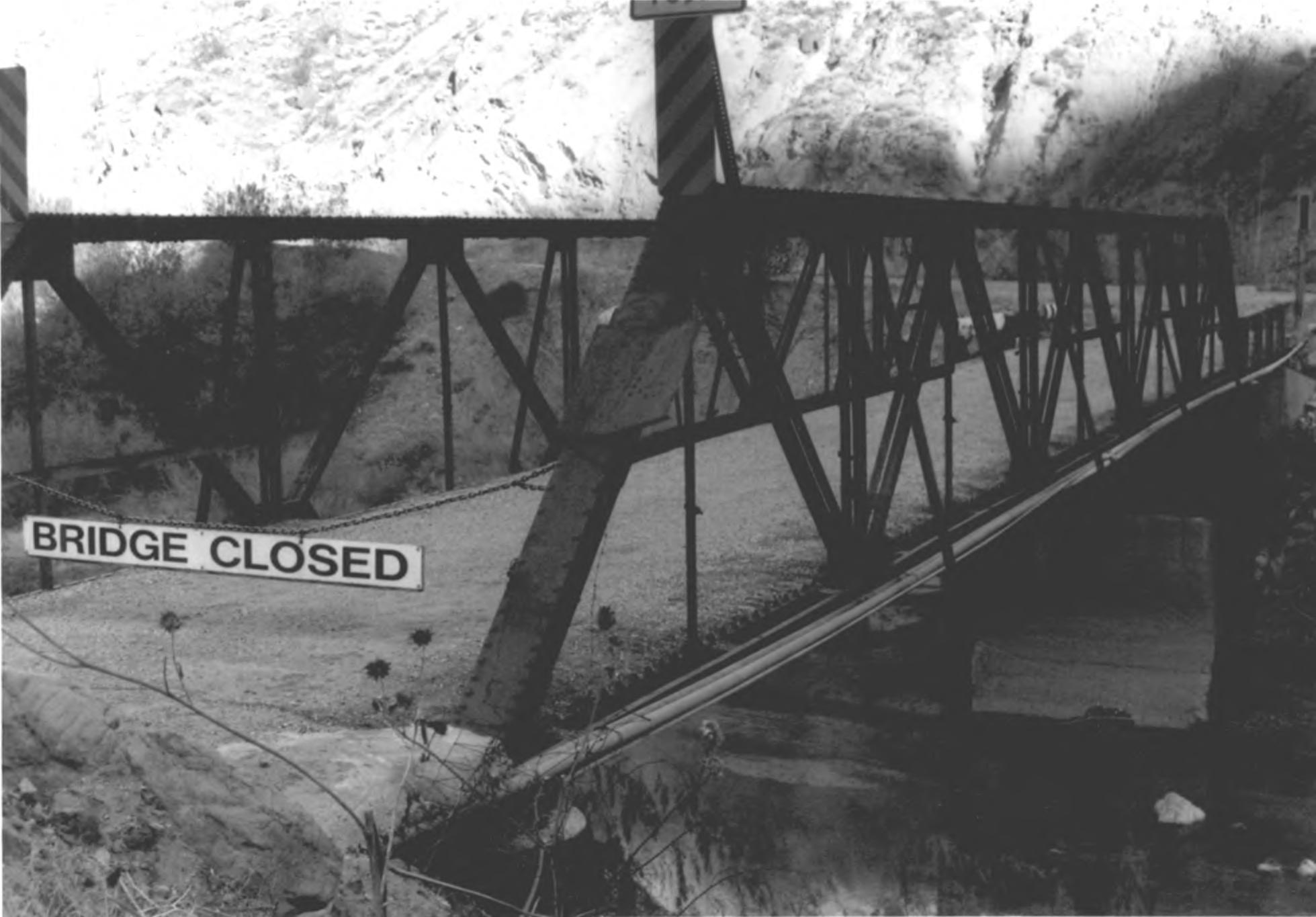
WASHINGTON COUNTY HISTORICAL SOCIETY (Washington County, Utah)
THE HURRICANE/LAVERKIN BRIDGE
(aka Hot Springs Bridge)
LOCATION
East of Highway 9, over the Virgin River.NE 1/4, NW 1/4, SE 1/4, SW 1/4, T41S, S25, R13W
DESCRIPTION
The 1908 Hurricane/LaVerkin bridge is constructed of steel and is referred to as a pony-truss bridge. This structure spans the Virgin River midway between the cities of Hurricane and LaVerkin in the Virgin River Canyon adjacent to a natural hot springs.The Hurricane/LaVerkin bridge is a steel, 5-panel, rigid connected Warren pony truss. Built in 1908, the original deck has been replaced with corrugated steel (date unknown). The structure is comprised of a single-span riveted Warren pony truss, 75' in length, supported by concrete-filled steel cylinder piers, and approached on both sides by steel stringer spans. Unlike most truss bridges that were built as through-truss types, with struts and braces across the top to connect the top chords, the Hurricane/LaVerkin Bridge is a pony-truss, without top bracing.
Although it no longer carries mainline traffic over the Virgin River (since the construction of the 1937 Hurricane Bridge), the Hurricane/LaVerkin Bridge continues to function in place with the replacement of its deck as the most serious alteration to date. This alteration does not significantly change the bridge's appearance and it maintains its historic integrity. The setting is relatively unchanged as well.
HISTORY
Constructed in 1908, the Hurricane/LaVerkin Bridge is historically and architecturally significant. The bridge incorporates distinctive characteristics in its method of construction, is one of the earliest and longest surviving examples of a rigid Warren pony truss type bridge in the state of Utah, and retains its historical design, material, and workmanship. The Hurricane/LaVerkin Bridge was the first link between LaVerkin and Hurricane, contributing to the development of these communities. Its historical role was that of a vital transportation link that contributed to the development of southwestern Utah.The bridge is historically significant in the development of southwestern Utah and in particular LaVerkin and Hurricane. The town of LaVerkin is located in an area known as the LaVerkin Bench. It was settled in the late 1890s and early 1900s with farming and fruit raising as its primary industries. Its agricultural beginning was promoted by Thomas Judd, a member of the LaVerkin Bench Canal Company who was instrumental in getting families to settle in this area. Water was always scarce and a major concern in the development of LaVerkin. The early period of development (c.1902) required maintaining an adequate water level in the LaVerkin Canal in addition to the usual farming duties. Culinary water was hauled from the Virgin River in large barrels on horse drawn sleds before the cistern water system was utilized. The Virgin River played a major role in this area by supplying water for the community. It also presented an obstacle in accessing communities and potential farmland to the south.
Across the Virgin River, directly opposite LaVerkin, is the town of Hurricane. Like LaVerkin, Hurricane was settled somewhat later than the surrounding towns (most towns in this area were established in the 1860s and 1870s). Hurricane was settled soon after the Hurricane Canal was completed in 1904, opening the Hurricane Bench for agriculture and prompting the formation of the town. The first families moved to Hurricane to make permanent homes in 1906. Stockholders in the canal company drew lots for both townsite lots and twenty-acre farm sites south of town. Schools, churches, and commercial buildings followed. The town grew quickly at first, attracting a population of 500 by 1912. By the late 1920s there were over 1200 people living in the town. Civic improvements came slowly. Electricity was brought to the town in 1917, a water system was installed in 1918, and a small sewer system was added in 1930 and expanded in 1946.
Prior to the building of the Hurricane/LaVerkin bridge, traveling from LaVerkin to Hurricane required crossing the stream bed of the LaVerkin Creek and the "treacherous" Virgin River. The building of the Hurricane/LaVerkin Bridge in 1908 by the state provided a sturdy steel girded bridge across the Virgin River.
Competitive bids were received by Washington County Board of Commissioners in January of 1908 for the building of the Hurricane/LaVerkin Bridge from two Midwestern bridge companies - Minneapolis Steel and the Midland Bridge Company. Midland underbid its competitor by $126 with their proposal of $3,299 and was awarded the contract to fabricate and erect the truss.
The history of the construction of the Hurricane/LaVerkin Bridge is summarized in local newspaper articles (Washington County News) written between March and July, 1908.
April 6, 1908:
The Road between here and Lund is reported to be in fine condition now, which will enable the teams that have gone to haul the materials for our steel bridge to come through without much trouble. C.H. Coleman, a Representative of the Midland Bridge Co. of Kansas City, Mo. has a force of men at work on the steel bridge just below Sulphur Springs. Work was begun April 2 and Mr. Coleman expects to put up the steel piers Thurs. Some of our citizens made their first visit to Hurricane. That town is booming. They spied the material and workmen on the Hurricane/Laverkin Bridge. No more awful dread when it is completed.
April 7, 1908:
The steel bridge between LaVerkin and Hurricane is now being put up. When it is finished watch Hurricane grow Come and walk on our steel bridge (the first in the County) bathe in our Sulphur Springs, view our beautiful scenery, walk through our orchards and vineyards. It will do your eyes good, then eat a dish of our strawberries, the best the world produces.
April 13, 1908:
The river is rising rapidly these hot days, being now almost to the danger point, for teams to ford. Good progress is being made on the bridge. All the piers are up filled with cement. Work will now begin on the bridge proper.
April 20, 1908:
--Our steel bridge is almost completed. A force of men began work on the approaches last week and it is expected that all will be ready for travel within a week or 10 days.
April 23, 1908:
County Commissioners Meeting reg session Mon. Among bills allowed was one for $2464.62 in favor of Greggory and Trocan Repre. the Midland Bridge Co. for the LaVerkin/Hurricane Bridge.
May 4, 1908:
Our steel bridge is now completed and will be ready for use as soon as the approached are finished. The bridge looks very substantial.
July 5, 1908:
...The band then crossed the new steel bridge to Hurricane...
This bridge, built over the river on a road that meandered through the Virgin River canyon, was the first, and for nearly three decades, the only link between LaVerkin and Hurricane. It was used for 29 years until 1937 when the concrete bridge that is currently being used was constructed.
ARCHITECTURE/CONSTRUCTION METHOD:
Metal truss bridges began to be designed and used in the early 1840s, and were of two basic types: Pratt and Warren. These bridges replaced most of the wood types and became the most popular designs between 1850 and 1925. The design called for the use of many small pieces or members to make a long truss that provided the necessary length and strength.
Prior to the State Road Commission's adoption of the Warren configuration for its standard pony truss design in the 1910s, bridge companies were marketing Warren trusses in Utah. Most of Utah's bridges were constructed by Salt Lake City bridge contractor James J. Burke, with a few being constructed by bridge firms such as the Midland Bridge Company of Kansas City, Missouri. The Hurricane/LaVerkin Bridge is significant in its illustration of an important method of construction and is the only known remaining Warren truss bridge in Utah.
Put on the National Register of Historic Places (#1995000413) on April 14, 1995.
PHOTOS

|

|
Other photos on the web:
Photos from the National Register of Historic Places nomination form
WCHS photos:
WCHS-01281 Photo of the bridge at LaVerkin Hot Springs
WCHS-01282 Photo of the bridges at LaVerkin Hot Springs
WCHS-01283 Photo of men & horses on the bridge between Hurricane and LaVerkin
REFERENCES
National Register of Historic Places, Inventory - Nomination FormBridgehunter.com entry for the Hurricane/LaVerkin Bridge